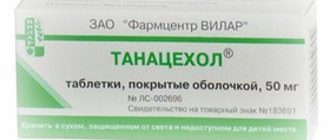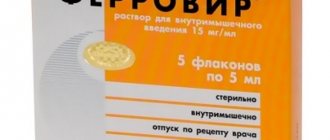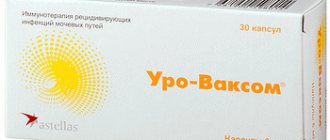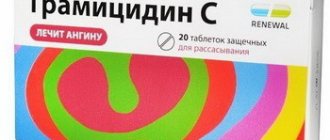Mydocalm instructions for use of the drug
Trade name: Mydocalm ® (Mydocalm) International nonproprietary name: No Dosage form: Solution for injection, 1 ml.
Mydocalm (Tolperisone/Lidocaine) in injections, 5 ampoules of 1 ml
Description and composition
With damage to the musculoskeletal system, “lumbago”, cervicobrachial osteochondrosis in the acute stage and other similar ailments, pain causes spasm of the muscles that limit movement in the affected area of the body. The spasm increases the pain, which causes the muscles to contract even more intensely. Drugs that help relax the muscle corset help break this vicious circle. Mydocalm belongs to such remedies.
Its active substance tolperisone is considered a centrally acting muscle relaxant. It has not yet been possible to fully understand how the drug works, which in no way prevents its active and successful practical use. Known properties of tolperisone:
- mild analgesic effect;
- cell membrane stabilizing abilities;
- blockade of a nerve impulse during its transmission through afferent/sensitive and motor neurons/motor;
- decreased sensitivity to pain in peripheral nerves;
- blockade of poly- and monosympathetic impulses of the spinal cord (spinal cord).
In the descriptions of the drug Mydocalm-Richter, you can find mention of another interesting, important, but unproven quality - the ability to prevent the release of mediators (bioactive substances) of pain. Presumably this quality is due to inhibition of Ca+ diffusion into presynapses.
In the trunk of the joint venture, this drug “builds” a barrier for the spread of excitation along the reculospinal tract. Mydocalm, penetrating into the blood, causes a decrease in the activity of certain areas of the reticular formation of the brain (brain).
This entire set of qualities and characteristics, perhaps obscure to the consumer, allows the Mydocalm-Richter drug to:
- reduce muscle stiffness/inelasticity;
- overcome pathologically increased muscle tone;
- reduce the susceptibility to spasms of muscle tissue in the affected area.
“At the exit” the patient receives a feeling of relief when moving and a decrease in the severity of pain.
The medication is well tolerated, so it can be prescribed to older patients. The leading advantages of the drug are what the drug does not do:
- does not sedate the nervous system;
- does not inhibit the higher functions of the GM;
- does not have a pronounced effect on the periphery of the nervous system;
- does not have a toxic effect on the heart and vascular system as a whole;
- has no genotoxic qualities (does not have the ability to cause mutations in the gene apparatus or stimulate tumor growth);
- is not capable of adversely affecting human reproduction.
All these points were tested at the stage of preclinical trials. And with proper course use, this drug did not lead to the realization of such risks.
A negative reaction was recorded only when doses of the drug were used that significantly exceeded the maximum permissible for humans. This means that they have no clinical significance. That is, with the correct dosage and duration of treatment, the described reaction will not happen again.
The drug Mydocalm-Richter is a combination product with two active ingredients:
- lidocaine;
- tolperisone.
Both substances are presented in the form of hydrochloride. Additional components of the liquid form are water, diethylene glycol monoethyl (ether), preservative.
In this combination, tolperisone has a weak antispasmodic and active muscle relaxant effect. Lidocaine acts as an anesthetic. When applied topically, it causes vasodilation in a specific area of the body, but does not have an irritating effect. With proper administration of the drug, its systemic effect on the body is not noticed.
Attention: lidocaine penetrates the plasma and blood-brain barriers and is actively excreted in breast milk.
Metabolizes tolperisone in the liver and kidneys, lidocaine in the liver, excreted in bile. The activity of tolperisone metabolites has not been established to this day.
What does Mydocalm help with?
Indications for use of the drug Mydocalm are:
pathologically increased muscle tone and spasms of skeletal (striated) muscle tissue, which are a consequence of organic lesions of the central nervous system, including multiple sclerosis, encephalomyelitis, cerebral stroke, etc.;- myogenic contractures, increased muscle tone and spasticity caused by diseases of the musculoskeletal system (for example, lubago with sciatica, spondylosis, arthrosis affecting large joints, cervical syndrome, etc.);
- non-inflammatory diseases of the brain accompanied by disorders of muscle tone (for example, cerebral palsy);
- cholelithiasis;
- severe pain syndrome, observed against the background of the development of hemorrhoids;
- menstrual pain syndrome;
- the threat of spontaneous abortion due to increased tone of the uterine muscle structures;
- renal colic.
The use of Mydocalm is permissible in the following situations:
- period of rehabilitation therapy. Specifically, after undergoing orthopedic, surgical or traumatological operations. This indication for taking the drug is associated with the ability of Tolperisone to have a positive effect on the level of stretching of muscle fibers;
- use in complex therapy for obliterating vascular lesions (the positive side of the drug’s effect in diabetic angiopathy, Raynaud’s syndrome, thromboangiitis obliterans, etc. has been proven);
- for the symptomatic treatment of muscle spasm in adult patients who have had a stroke;
- for pathologies caused by disorders of vascular innervation (severe gait disturbances or pathological cyanosis of the extremities).
The use of Mydocalm for the disease - osteochondrosis
Mydocalm is a centrally acting relaxant. The pain syndrome that develops with osteochondrosis provokes a compensatory spasm of the deep layers of the back muscles. Myofixation of the spinal column and limited mobility of spinal motion segments often occur. The consequence of muscle-tonic imbalance is a worsening of the course of the disease and a decrease in the therapeutic effectiveness of all measures taken.
Muscle relaxants for osteochondrosis are applicable to eliminate this imbalance.
Drugs from this pharmacotherapeutic group:
have a sedative effect;- relieve or reduce the symptomatic effect of pain;
- suppress spinal reflexes;
- relieve muscle tension and help relax the body's muscles.
Muscle relaxants, due to their qualities, help increase the effectiveness of such therapeutic measures as massage, physical therapy, traction therapy, etc. They also have a unique ability to potentiate the effect of blockades, other painkillers and physiotherapeutic procedures.
Relaxers have a number of contraindications. Pay attention to this.
Muscle relaxants, having a number of contraindications for use, can provoke unwanted side effects. Namely, with long-term treatment, the function of the hepatobiliary system is often disrupted in patients and body weight increases.
But, unlike chondroprotective drugs, they quickly improve the condition of patients suffering from osteochondrosis. This is ensured by removing pathological myofixation, and therefore increases the effectiveness of conservative therapy.
When treating osteochondrosis, the dosage of muscle relaxants is prescribed in short courses. Quite often, given the wide range of side effects, medical practitioners are extremely careful when including such medicinal elements in the treatment regimens of their patients.
Indications for use
for adults
Mydocalm-Richter has proven itself well when used to facilitate the recovery period after operations:
- in surgical;
- orthopedic;
- trauma profile.
The injection form of the drug is effective for spasticity of skeletal muscles of various origins: from damage to the musculoskeletal system (movement apparatus) to organic changes in the central nervous system:
- GM stroke;
- multiple sclerosis;
- damage to the pyramidal tracts;
- and spinal cord injuries.
As a combination therapy, Mydocalm-Richter is indicated for patients with obliterating vascular pathologies and disorders of vascular innervation.
for children
The use of this drug for children under 18 years of age is not approved by the product label.
for pregnant women and during lactation
Mydocalm has been studied in pregnant animals. Toxicity to the fetus has not been detected. However, there is no data on the use of this medication in women during the gestational period and no confirmation of its non-toxicity. Therefore, Mydocalm-Richter is not prescribed in the first trimester of pregnancy. At later dates, the prescription of medication remains at the discretion of the doctor. The indications will be the same as outside of gestation.
Since lidocaine clearly penetrates into milk, and there is no established data regarding tolperisole, Medokalm-Richter is not prescribed to lactating women. If the patient's condition requires urgent use of muscle relaxants of this group, the child should be weaned.
Pharmacology of Mydocalm
Now there is no exact answer as to how the main substance from the drug works. The main ingredient is known - tolperisone hydrochloride. It is perceived as an active substance on nervous tissue. Thanks to this, the drug is considered quite effective in the field of anesthetics, and domestic ones at that. It has been proven to serve as an obstacle to the spread of pathological nerve signals that follow from the internal organs to the central nervous system, and is used to reduce standard muscle stiffness.
What is very important, the drug does not have a negative effect on the cerebral cortex (namely, Tolperisone). The patient is maintained in a state of wakefulness, activity, kidney function and blood formation.
Side effects
Mydocalm-Richter is well tolerated by patients. But no drug is suitable for 100% of patients. This drug is no exception. Infrequently, but still the medication becomes the cause:
- allergic reactions from skin manifestations to anaphylaxis;
- headaches and noticeable dizziness;
- weakness and drowsiness;
- increased blood pressure and shortness of breath;
- disruption of the digestive system from mild discomfort and nausea, diarrhea and vomiting.
If these signs or other undescribed symptoms appear, you should contact the doctor who prescribed this treatment.
special instructions
Mydocalm injections are administered only to adults. The medication is used with extreme caution by patients with moderate renal impairment; in case of severe disease, the use of the medication is strictly prohibited.
With liver dysfunction, the incidence of adverse reactions increases. In case of severe disorders of the organ, it is highly not recommended to use the medication.
You can only inject yourself if you have the appropriate experience. It is recommended to periodically change the injection site, otherwise it will be a painful injection.
Women who have hypersensitivity to certain medications and a history of allergic reactions to medications are more susceptible to side effects. Careful adherence to the prescribed dosage is required.
During the Mydocalm course, it is important to monitor your health. Any symptoms of hypersensitivity are an indication for immediate medical attention. In this case, the drug is discontinued or the dosage is adjusted.
Drug interactions
The Mydocalm injection must be administered separately from other medications. Mixing this solution with other medications in one syringe is prohibited. Mydocalm can be used with sedatives and sleeping pills. Its use with medications that contain ethanol is permitted.
Mydocalm is used with caution in combination with non-steroidal anti-inflammatory drugs. This requires adjustment of the doses of both medications, since the first enhances the therapeutic effect of NSAIDs, which increases the likelihood of adverse reactions.
Mydocalm, due to its weak sedative effect on the central nervous system, can be combined with tranquilizers and hypnotics.
If complex use of Mydocalm with drugs from the group of muscle relaxants is required, it is necessary to adjust the dose of all in order to avoid the occurrence of side effects.
Mydocalm enhances the therapeutic effect of drugs used for general anesthesia, muscle relaxants that have peripheral effects, psychotropic medications and Clonidine.
Alcohol compatibility
The combined use of Mydocalm with medications that contain ethanol is allowed. But the consumption of alcoholic beverages during therapy is not recommended.
Impact on transport management
It is recommended to refrain from driving a car or operating complex machinery. The drug can have a depressant effect on the central nervous system, reducing concentration, leading to drowsiness and attacks of dizziness. If the medication is well tolerated and there are no side effects, there are no restrictions on driving.
Analogs
An analogue for the drug Mydocalm is the drug Tolperezon. It differs from the described product in the absence of lidocaine in the composition. This means that there is no local anesthetic effect. The patient will feel relief. But it will be justified solely by its muscle-relaxing effect. Mydocalm-Richter can be replaced with Calmirex. In composition, it completely repeats Mydocalm.
As a replacement, if tolperesone is not suitable, the doctor may name another muscle relaxant with central action, for example, based on tizanidine (Tizanidine, Tizalud, Tizanil, Sirdalud). Its main effect is associated with the influence on α-2 receptors of presynapses. This leads to the fact that the transmission of nerve impulses is inhibited at the level of interneurons of the spinal cord. Preparations with this active ingredient reduce spasticity and fight clonic convulsions. The medicine is effective both for cerebral muscle spasm and for spastic conditions of spinal origin.
Dosage
The frequency of administration and the dose of each dose should be determined by the attending physician based on the severity of symptoms, the course of the disease, the patient’s weight, drug tolerance and other factors. For adults, as a rule, a dosage of 150-450 mg is used, divided into 2-3 doses per day. You can start therapy with small doses (50 mg 3 times a day), bringing it to the minimum effective.
1 ml should be administered intramuscularly twice a day; a single injection intravenously is sufficient.
In children from 3 months of age, the drug is used at the rate of 5 mg per kilogram of body weight per day. In children aged 3 years and older, it is recommended to use doses of 2-4 mg per kilogram of body weight per day. The frequency of administration is recommended at least 3 times a day. Mydocalm should be taken with meals.
Treatment during pregnancy
Unfortunately, at the moment there are no significant clinical data regarding the safety of the Mydocalm-Richter solution for pregnant women. Although experimental studies have not revealed any teratogenic effects.
However, pregnant women are not prescribed injections with this drug. Only in rare cases - when the expected benefit exceeds or justifies the likely risk.
But you definitely cannot be treated with Mydocalm while breastfeeding. And if the doctor strictly prescribed this drug, you will have to transfer the baby to artificial formulas for his own good.
Overdose
The injection solution almost never causes an overdose, because the composition of the drug provides a high therapeutic threshold. Only a doctor can increase or decrease the dose. If the patient has not studied the instructions or ignored the doctor’s recommendations, the following symptoms may occur:
- difficulty breathing;
- significant muscle weakness, which is characterized by loss of motor interaction of individual muscles;
- sudden attacks of severe convulsions;
- There is no antidote for the active component of the injection solution, so overdose therapy is based on symptom removal and supportive treatment.
Contraindications
Contraindications to the use of Mydocalm-Richter are:
- hypersensitivity to any of the active or auxiliary substances included in the drug (including lidocaine and other amide drugs that have a local anesthetic effect);
- myasthenia gravis in severe form;
- pregnancy;
- lactation.
The drug also has age restrictions: injections of the drug are contraindicated for persons under 18 years of age.
Interaction with other drugs
Mydocalm combines well with analgesics and NSAIDs, which is of great practical importance. The simultaneous use of drugs with a number of NSAIDs makes it possible to reduce the dose of the latter in order to minimize their side effects without reducing the effectiveness of therapy.
There are medications that can enhance the effect of Mydocalm. These include:
- psychotropic drugs;
- Clonidine (hypotensive drug);
- peripherally acting muscle relaxants.
Mydocalm is not addictive and does not have a sedative effect, so it can be used in combination with sleeping pills and sedatives, as well as drugs containing alcohol.
Pharmacokinetics
After the Mydocalm injection, the main active ingredient of the drug is intensively metabolized in the kidneys and liver. It is also excreted by a paired organ, 99% in the form of metabolites (their pharmacological activity, unfortunately, is unknown). When administered intravenously, the half-life is one and a half hours.
Lidocaine is completely adsorbed, the maximum concentration is reached after 30-45 minutes. This substance binds to plasma proteins by 50-80%. Lidocaine is also quickly distributed in organs and tissues. You need to know that it is secreted in milk and penetrates the placental barrier, as well as the BBB.
Lidocaine is also metabolized in the liver, approximately 90-95%. Microsomal enzymes take part in this process. Only 10% is excreted unchanged along with bile and kidneys.









